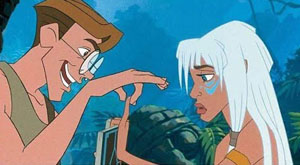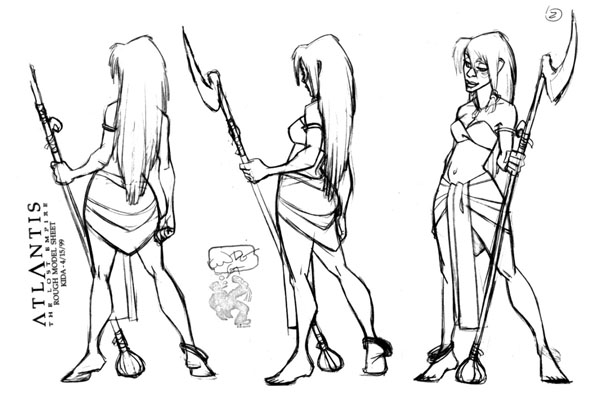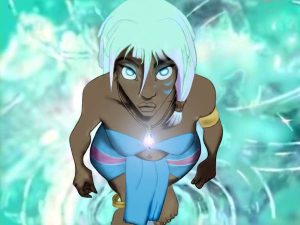 Suspended Animation #397
Suspended Animation #397
The bakers dozen official princesses in the Disney Princess Franchise are Snow White, Cinderella, Aurora (Sleeping Beauty), Ariel, Belle, Jasmine, Pocahontas, Mulan, Tiana, Rapunzel, Raya, Merida and Moana.
Technically, Pocahontas and Moana (who are just daughters of a chief) as well as Mulan are not actual princesses and Belle and Tiana are considered Princess Consorts or commoners who married into royalty.
 Originally Esmeralda and Tinker Bell were part of the franchise but were dropped within a year because it was felt that they did not align with the brand.
Originally Esmeralda and Tinker Bell were part of the franchise but were dropped within a year because it was felt that they did not align with the brand.
Several official Disney princesses are missing from the franchise including Anna and Elsa from Frozen (2013) although most people just assume they are part of the group and they sometimes appear with the others but they have a successful and extensive brand just on their own.
The unofficial rules for the Disney franchise is that the princess must be the star of her own theatrical film, the film was successful at the box office (even Merida who is the least popular of the group has generated hundreds of million of dollars) and must be human and not an animal or insect (even though Tiana spends eighty percent of her film as a frog).
 That is meant to help explain why several actual Disney princesses are missing including Ariel’s six older sisters: Attina, Alana, Adella, Aquata, Arista and Andrina as well as Ariel’s daughter Melody who only appeared in a straight-to-video sequel. .
That is meant to help explain why several actual Disney princesses are missing including Ariel’s six older sisters: Attina, Alana, Adella, Aquata, Arista and Andrina as well as Ariel’s daughter Melody who only appeared in a straight-to-video sequel. .
Others like Maid Marian from Robin Hood and Nala from The Lion King and even Faline who marries Bambi who is the Prince of the Forest in Bambi are eliminated because they are animals.
Princess Vanellope von Schweetz from Wreck It Ralph and Sofia from Sofia the First are considered too young to be included.
However, one of the most prominently missing princesses appeared in a Disney animated feature that the Walt Disney Company would like to forget.
One of the abiding themes in many Disney animated films is the enormous growth of character that happens when two people of different cultures interact.
 It is even more challenging when the white-haired warrior princess is over eight thousand years old as in the animated feature Atlantis: The Lost Empire (2001) and her interaction is with a sheltered, bespectacled twenty-something cartographer and linguist named Milo Thatch in 1914.
It is even more challenging when the white-haired warrior princess is over eight thousand years old as in the animated feature Atlantis: The Lost Empire (2001) and her interaction is with a sheltered, bespectacled twenty-something cartographer and linguist named Milo Thatch in 1914.
When a wounded Milo lays unconscious in a darkened corner of the cavern, he I surrounded by Atlantean masked warriors who are about to kill him when their fierce leader stops them with “he doesn’t appear hostile”.
Milo awakens to find himself finds himself face-to-face with the intimidating leader who lifts her elaborate mask to reveal the beautiful tattooed visage of Princess Kida.
She is the daughter of Kashekim Nedakh, the King of Atlantis. At the end of the film with the death of her father, she becomes queen. Her fighting style incorporates aspects of Thai boxing and she wields a deadly Atlantean spear. Like the other Atlanteans she wears a blue crystal shard around her neck that can be used for healing and also provides a form of immortality.
 The masks are a mixture of Polynesian and West African. Producer Don Hahn said, “”The fact that you can’t quite place it is a good thing. We didn’t want to do the Greco-Roman Atlantis. We didn’t want to do the Aquaman kind of version of it.
The masks are a mixture of Polynesian and West African. Producer Don Hahn said, “”The fact that you can’t quite place it is a good thing. We didn’t want to do the Greco-Roman Atlantis. We didn’t want to do the Aquaman kind of version of it.
“We thought: Let’s take the idea that Atlantis the mother civilization. If it was a truly Tower-of-Babel advanced civilization, that meant its architecture, language and culture must have inspired all the other great cultures of the world. That was our beginning of taking Mayan, Cambodian and Indian architecture and devolving them almost into what Atlantis was like. The land of Atlantis, when viewed from a mountaintop resembles the temple structure of Angkor Wat.”
Composer James Newton Howard’s score for the film has been described as “quiet and mysterious” by one reviewer. However, Howard used chimes, flutes and a chorus on one of his favorite tracks, “Milo meets Kida”, to create what he said was “a feeling of cuteness and humor” for the moment. .
Cree Summer Francks, the original voice of Kida, remarked, “Milo annoys her a little bit at first and that fascinates her. Of course, that fascination leads to something much more.”

Francks has supplied the voices for several Disney animated feature film and television characters as well as voicing Kida in the 2003 sequel Milo’s Return where Kida is married to Milo. The sequel is stitched together from three episodes for a Disney television series Team Atlantis that was cancelled before it aired because the theatrical film did so poorly.
“Kida is strong willed and knows what she wants. She is tough but cute. Her words can seem harsh so you have to look at what’s behind her words. She has a playful side and it only comes out when she’s with Milo,” stated Kida’s supervising animator Randy Haycock.
 Haycock wanted her to look different than a typical Disney princess so he designed her with a wider nose, fuller lips and looking a little older, physically appearing somewhere in her late 20s.
Haycock wanted her to look different than a typical Disney princess so he designed her with a wider nose, fuller lips and looking a little older, physically appearing somewhere in her late 20s.
Haycock was initially intimidated by Francks wild and unique personality but incorporated aspects of it into Kida. Kida’s name originates from a Kiowa girl’s name meaning “raising away the darkness.” According to Haycock Kida’s facial tattoos are meant to symbolize tears that Kida had at the loss of her mother.
According to Milo’s Journal, “Kida explained that the ritual branding of complex inked designs was an integral part of Atlantean culture. As among the tribes native to New Zealand, the number and arrangement of these permanent skin decorations was determined by physical, intellectual, artistic or cultural achievement. The hierarchy and explication of these emblematic citations appeared rich and complex.” Because they were too complex to animate, they disappear in the sequel.
The respect and affection between Kida and Milo continues to grow as she tours him through the bustling marketplace. They hesitantly share information about each other’s lives and it is clear that an emotional bond has been created during this colorful journey.
 Concerned Kida hopes that this pre-occupied scholar can help unlock the mysteries of Atlantis’ past and perhaps save its future. Having Milo translate a sunken mural is the key to revealing the long lost secret.
Concerned Kida hopes that this pre-occupied scholar can help unlock the mysteries of Atlantis’ past and perhaps save its future. Having Milo translate a sunken mural is the key to revealing the long lost secret.
As Kida and Milo unashamedly peel off their clothing to swim to a sunken mural, the film’s directors stated that the characters are at the same time symbolically peeling off emotional layers that make them more vulnerable to each other. Producer Hahn claims that this pivotal moment in the film not only reveals important information but firmly establishes the relationship.
Hahn pointed out that “When they are in the underwater dome air pocket, it forces the two of them together so that we just see two faces next to each other and the lighting gives it a nice romantic quality.”
“The exploration of the mural not only satisfies the necessary exposition of the Atlantean history but there is also an element of a sub-textual romance as they solve a mystery together,” added Director Kirk Wise.
Amusingly, when Kida appeared as a walk-around character in the Disney theme parks, she was clad in her elaborate queen costume because it felt that her skimpy and revealing princess outfit would be controversial to guests.
Disney fans have lobbied for Kida to be included in the Disney Princess Franchise but the Walt Disney Company hems and haws suggesting the film was not successful and that Kida is a supporting character like the mercenaries in the film. They now state the character just does not fit into the “Princess mythology”.


 Jim Korkis is an internationally respected animation historian who in recent years has devoted his attention to the many worlds of Disney. He was a columnist for a variety of animation magazines. With his former writing partner, John Cawley, he authored several animation related books including The Encyclopedia of Cartoon Superstars, How to Create Animation, Cartoon Confidential and Get Animated’s Animation Art Buyer’s Guide. He taught animation classes at the Disney Institute in Florida as well as instructing classes on acting and animation history for Disney Feature Animation: Florida.
Jim Korkis is an internationally respected animation historian who in recent years has devoted his attention to the many worlds of Disney. He was a columnist for a variety of animation magazines. With his former writing partner, John Cawley, he authored several animation related books including The Encyclopedia of Cartoon Superstars, How to Create Animation, Cartoon Confidential and Get Animated’s Animation Art Buyer’s Guide. He taught animation classes at the Disney Institute in Florida as well as instructing classes on acting and animation history for Disney Feature Animation: Florida.




















































It’s interesting how the hugely successful Disney Princess branding manages to include CG animated characters like Rapunzel, Raya, Merida and Moana reimagined in a Golden Age/Renaissance Traditional/2D style that does not take away, indeed perhaps even adds, appeal to the characters and doesn’t seem to have dinted the commercial success of the brand at all. Almost as if…oh, never mind
Well, of course Disney has every right to decide which of its characters will or won’t be part of the Princesses franchise. Some of the company’s excuses for Kida’s omission don’t really hold water, like the fact that the movie wasn’t a success at the box office (neither was “Sleeping Beauty”), or that she is merely a supporting character (she’s the female love interest and plays a crucial role in the plot). Still, I can see their point.
“Atlantis: the Lost Empire” simply isn’t Kida’s movie in the sense that “The Little Mermaid” is Ariel’s, or “Moana” Moana’s. It’s also a fairly adult- or teen-oriented film; Princess Eilonwy from “The Black Cauldron” could be excluded on those grounds alone, even if she were a real princess and didn’t merely call herself one. But above all, Princess Kida is just too selfless a character to be very relatable. Her single-minded desire to save her civilisation from stagnation and decay by returning it to the glory days of its past — to make Atlantis great again — isn’t going to resonate strongly with the little girls whom Disney targets with its Princesses franchise. At least, I hope not.
The strapless, twist-front bikini top that Kida wears was a fad of the 1990s; I haven’t seen one in many years. I wonder how they stayed on. Maybe you had to glue them into place.
Well, Jasmine isn’t the main star (more of a co-star) of “Aladdin”, but she’s part of the franchise.
In fairness, Sleeping Beauty had fairly strong ticket sales, it was just a flop relative to its budget, and by 1980 it was a lot better known than Atlantis is now, certainly by the time the Disney Princess branding started. Granted, I wouldn’t say these were level playing fields, but it’s how things have worked out.
Plus, “Sleeping Beauty” got into The Library of Congress’ National Film Registry about three years ago.
I always feel “slighted” when Giselle gets “snubbed” within all this. She is the Disney Princess who is the spoof of allllllllll D Princessessessess!
When I was working at Walt Disney World, I asked the powers-that-be why there was no “walk around” Giselle character since so many guests kept asking me where they could meet her and was told the official explanation was that since she did not marry a prince, she was no a real princess.
The actual reason is that Disney would have had to pay Amy Adams a fee for using her physical representation as they did for Johnny Depp’s Captain Jack Sparrow.
I never realized years later after “Atlantis was released was voiced by the same actress of Elmyra Duff and (in case, Cheryl is reading this article) Susie Crarmicheal! That shows how versatile Cree is.
Cree’s probably best known for playing Winifred “Freddie” Brooks in “A Different World,” a role she made her own.
Yeah, but she’s also a prominent voice actress. She’s been doing since she was a kid (her later father was also a well-known voice over artist in Canada).
In addition to being too young, I thought that Vanellope abdicated her royalty. As far as I can think of, the Wreck it Ralph series was the only Disney franchise to take on a kind of anti-monarchist tone.
I’m never surprised by any weird thing Disney does. They basically invented corporate culture!
Well, she sure was hot though.
Saw this as a kid in the cinema. Needless to say that this shaped a larged a large part of my fascination for ancient history and geography.